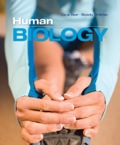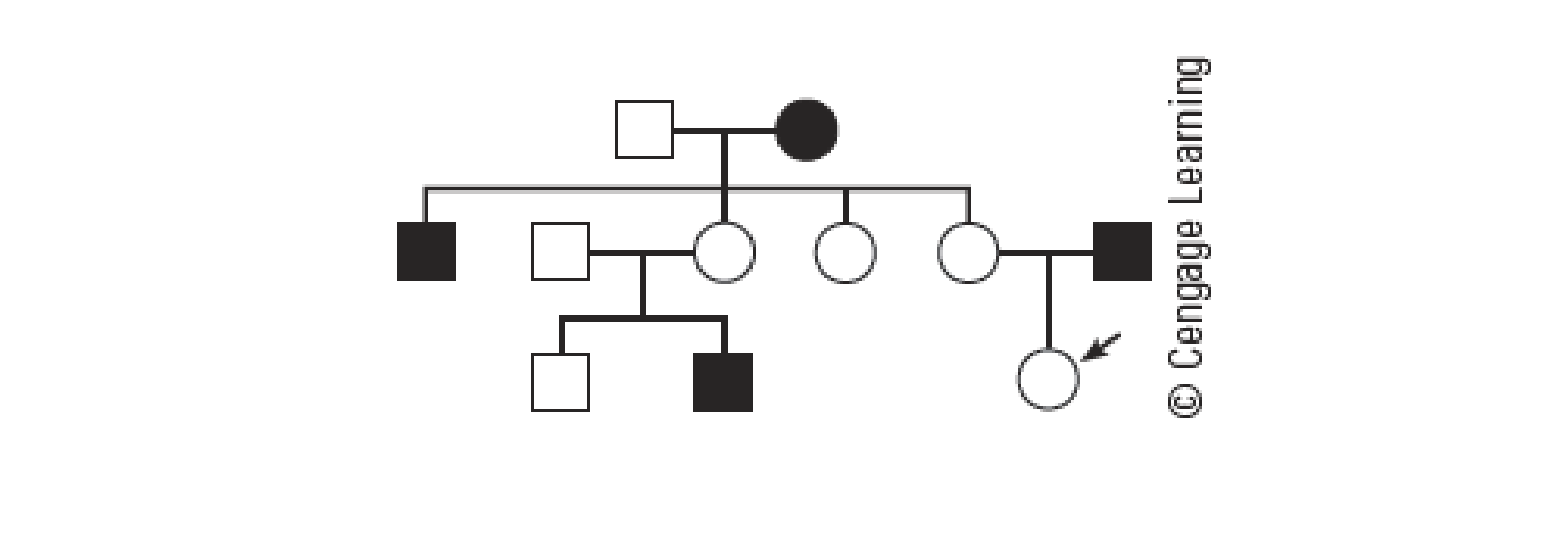
EBK HUMAN BIOLOGY
11th Edition
ISBN: 8220100545931
Author: MCMILLAN
Publisher: Cengage Learning US
expand_more
expand_more
format_list_bulleted
Concept explainers
Textbook Question
Chapter 20, Problem 7CT
The following pedigree shows the pattern of inheritance of red-green color blindness in a family. Females are shown as circles and males as squares; the squares or circles of individuals affected by the trait are filled in black. What is the chance that a son of the third-generation female indicated by the arrow will be color blind if the father is not color blind? If he is color blind?

Expert Solution & Answer
Trending nowThis is a popular solution!

Students have asked these similar questions
unu grow
because auxin is still produced in
the tip
to
Another of Boysen and Jensen's experiments included
the use of mica, explain why one of the shoots was
able to show phototropism and the other was not.
Mica Wafer
Ligh
c. They then t
but this time
permeable n
shoot. Why
phototropis
Light
Mica Wafer
Coleoptile tips
Tips removed: agar
Explain why the shoo
direction after the ag
the cut shoot, even t
Discussion entries must be at least 250 words to fulfill the assignment
requirements. You must complete your entry before you will be able to see the
responses of other students. Responses to other students are encouraged but not
required. Grading for discussion entries will be based on application of course
concepts, proper grammar, and correct punctuation.
Read one the attached article and explore the Human Development Index
(https://hdr.undp.org/data-center/human-development-index#/indicies/HDI).
In your opinion, is the Human Development Index a good measure of the well-
being of the people of a nation? Are the items measured in the HDI valid and
relevant in the modern global economy? How are they related to the political
economy of a nation?
The attached articles propose some alternative measures of well-being. In your
opinion, are there other measures of well-being that might be better alternatives
to the items in the current HDI?
A patient visits her doctor with symptoms typical of a bladder infection. She is immediately prescribed an 800 mgdose of antibiotic (bioavailability = 1/2, t½ = 12 h). The corresponding plasma concentration of drug is found to be 96 micrograms/ml. What is the volume of distribution of this drug? Please round to the nearest liter.
Chapter 20 Solutions
EBK HUMAN BIOLOGY
Ch. 20 - Prob. 1RQCh. 20 - What is a carrier of a genetic trait?Ch. 20 - What evidence indicates that a trait is coded by a...Ch. 20 - Prob. 4RQCh. 20 - Explain what nondisjunction is, and give two...Ch. 20 - _______ segregate during ______. a. Homologues;...Ch. 20 - Prob. 2SQCh. 20 - Genes on the same chromosome tend to stay together...Ch. 20 - Prob. 4SQCh. 20 - A chromosomes structure can be altered by _______....
Ch. 20 - Nondisjunction can be caused by ________. a....Ch. 20 - A gamete affected by nondisjunction could have...Ch. 20 - Genetic disorders can be caused by __________. a....Ch. 20 - A person who is a carrier for a genetic trait...Ch. 20 - Prob. 10SQCh. 20 - If a couple has six boys, what is the probability...Ch. 20 - Human sex chromosomes are XX for females and XY...Ch. 20 - People with Down syndrome have an extra copy of...Ch. 20 - Prob. 4CTCh. 20 - Prob. 5CTCh. 20 - About 4 percent of people of Northern European...Ch. 20 - The following pedigree shows the pattern of...
Knowledge Booster
Learn more about
Need a deep-dive on the concept behind this application? Look no further. Learn more about this topic, biology and related others by exploring similar questions and additional content below.Similar questions
- A 10 mg/Kg dose of a drug is given by intravenous injection to a 20 Kg dog. What would the volume of distribution be if the drug had been given orally and only 50% of the drug was absorbed (the concentration of drug at time = 0 is 0.1 mg/L)? Be sure to show your work.arrow_forwardAfter oral administration of 10mg of a drug, 50% is absorbed and 40% of the amount absorbed is metabolized by the first pass effect. The bioavailable dose of this drug is ______. Make sure to provide units for your answer. Show your work.arrow_forwardA 10 mg/Kg dose of a drug is given by intravenous injection to a 20 Kg dog. What is the volume of distribution of the drug in liters if the plasma concentration is 0.1 mg/L (assume the drug is instantaneously distributed)? Be sure to show your work.arrow_forward
- Using a BLAST search, what class of proteins is similar to bovine angiogeninarrow_forwardIdentify an article within a Nursing Journal. Discuss how the issue within the article impact how we provide care. Please give in text citations and list references.arrow_forwardI have a question. I need to make 25 mL of this solution . How would I calculate the math? Please helparrow_forward
- Introduction to blood lab reportarrow_forwardWhich of the structural components listed in the Essential terms of section 1.3 (Cell components) could occur in a plant cell? Paragraph く BIUA 川く く 80 + кл Karrow_forwardWhich of the following statements refer(s) directly to the cell theory? (Note that one or more correct answers are possible.) Select 2 correct answer(s) a) There are major differences between plant and animal cells. b) There are major differences between prokaryote and eukaryote cells. c) All cells have a cell wall. d) All cells have a cell membrane. e) Animals are composed of cells. f) When a bacterial cell divides, it produces two daughter cells.arrow_forward
- Preoperative Diagnosis: Torn medial meniscus, left knee Postoperative Diagnosis: Combination horizontal cleavage tear/flap tear, posterior horn, medial meniscus, left knee. Operation: Arthroscopic subtotal medial meniscectomy, left knee Anesthetic: General endotracheal Description of Procedure: The patient was placed on the operating table in the supine position and general endotracheal anesthesia was administered. After an adequate level of anesthesia was achieved, the patient's left lower extremity was prepped with Betadine scrubbing solution, then draped in a sterile manner. Several sites were then infiltrated with 1% Xylocaine solution with Epinephrine to help control bleeding from stab wounds to be made at these sites. These stab wounds were made anterolaterally at the level of the superior pole of the patella for insertion of an irrigation catheter into the suprapatellar pouch area, anterolaterally at the level of the joint line for insertion of the scope and anteromedially at…arrow_forwardUARDIAN SIGNA Life Sciences/ Baseline Test Grade 10 ry must be written in point form. pot in full sentences using NO MORE than 70 words sentences from 1 to 7. only ONE point per sentence. words as far as possible. number of words you have used in brackets at the end GDE/2024 QUESTION 3 The table below shows the results of an investigation in which the effect of temperature and light on the yield of tomatoes in two greenhouses on a farm was investigated. TEMPERATURE (°C) AVERAGE YIELD OF TOMATOES PER 3.1 PLANT (kg) LOW LIGHT LEVELS HIGH LIGHT LEVELS 5 0,5 0,5 10 1,5 2,5 15 3,0 5,0 20 3,6 8,5 25 3,5 7,8 30 2,5 6,2 State TWO steps the investigator may have taken into consideration during the planning stage of the investigation. (2) 3.2 Identify the: a) Independent variables (2) b) Dependent variable (1) 3.3 Plot a line graph showing the results of the average yield of the tomatoes from 5°C to 30°C for low light levels. (6) 3.4 State ONE way in which the scientists could have improved the…arrow_forwardExplain why you chose this mutation. Begin by transcribing and translating BOTH the normal and abnormal DNA sequences. The genetic code below is for your reference. SECOND BASE OF CODON כ FIRST BASE OF CODON O THIRD BASE OF CODON SCAGUCAGUGAGUCAG UUU UUC UCU UAU UGU Phenylalanine (F) Tyrosine (Y) Cysteine (C) UCC UAC UGC Serine (S) UUA UUG Leucine (L) UCA UCG_ UAA UGA Stop codon -Stop codon UAG UGG -Tryptophan (W) CUU CUC CCU CAU CGU Histidine (H) CCC CAC CGC -Leucine (L) Proline (P) CUA CCA CAA CUG CCG CAG-Glutamine (Q) -Arginine (R) CGA CGG AUU ACU AAU AGU AUC Isoleucine (1) Asparagine (N) ACC AAC Threonine (T) AUA ACA AAA Methionine (M) Lysine (K) AUG ACG Start codon AAG AGC-Serine (S) -Arginine (R) AGA AGG GUU GCU GAU GUC GUA GUG GCC Valine (V) -Alanine (A) GCA GCG GAC GAA GAG Aspartic acid (D) GGU Glutamic acid (E) GGC GGA GGG Glycine (G) In order to provide a complete answer to the question stated above, fill in the mRNA bases and amino acid sequences by using the Genetic Code…arrow_forward
arrow_back_ios
SEE MORE QUESTIONS
arrow_forward_ios
Recommended textbooks for you
 Human Biology (MindTap Course List)BiologyISBN:9781305112100Author:Cecie Starr, Beverly McMillanPublisher:Cengage Learning
Human Biology (MindTap Course List)BiologyISBN:9781305112100Author:Cecie Starr, Beverly McMillanPublisher:Cengage Learning
 Human Heredity: Principles and Issues (MindTap Co...BiologyISBN:9781305251052Author:Michael CummingsPublisher:Cengage Learning
Human Heredity: Principles and Issues (MindTap Co...BiologyISBN:9781305251052Author:Michael CummingsPublisher:Cengage Learning Concepts of BiologyBiologyISBN:9781938168116Author:Samantha Fowler, Rebecca Roush, James WisePublisher:OpenStax College
Concepts of BiologyBiologyISBN:9781938168116Author:Samantha Fowler, Rebecca Roush, James WisePublisher:OpenStax College Biology (MindTap Course List)BiologyISBN:9781337392938Author:Eldra Solomon, Charles Martin, Diana W. Martin, Linda R. BergPublisher:Cengage Learning
Biology (MindTap Course List)BiologyISBN:9781337392938Author:Eldra Solomon, Charles Martin, Diana W. Martin, Linda R. BergPublisher:Cengage Learning Biology Today and Tomorrow without Physiology (Mi...BiologyISBN:9781305117396Author:Cecie Starr, Christine Evers, Lisa StarrPublisher:Cengage Learning
Biology Today and Tomorrow without Physiology (Mi...BiologyISBN:9781305117396Author:Cecie Starr, Christine Evers, Lisa StarrPublisher:Cengage Learning

Human Biology (MindTap Course List)
Biology
ISBN:9781305112100
Author:Cecie Starr, Beverly McMillan
Publisher:Cengage Learning


Human Heredity: Principles and Issues (MindTap Co...
Biology
ISBN:9781305251052
Author:Michael Cummings
Publisher:Cengage Learning

Concepts of Biology
Biology
ISBN:9781938168116
Author:Samantha Fowler, Rebecca Roush, James Wise
Publisher:OpenStax College

Biology (MindTap Course List)
Biology
ISBN:9781337392938
Author:Eldra Solomon, Charles Martin, Diana W. Martin, Linda R. Berg
Publisher:Cengage Learning

Biology Today and Tomorrow without Physiology (Mi...
Biology
ISBN:9781305117396
Author:Cecie Starr, Christine Evers, Lisa Starr
Publisher:Cengage Learning
How to solve genetics probability problems; Author: Shomu's Biology;https://www.youtube.com/watch?v=R0yjfb1ooUs;License: Standard YouTube License, CC-BY
Beyond Mendelian Genetics: Complex Patterns of Inheritance; Author: Professor Dave Explains;https://www.youtube.com/watch?v=-EmvmBuK-B8;License: Standard YouTube License, CC-BY